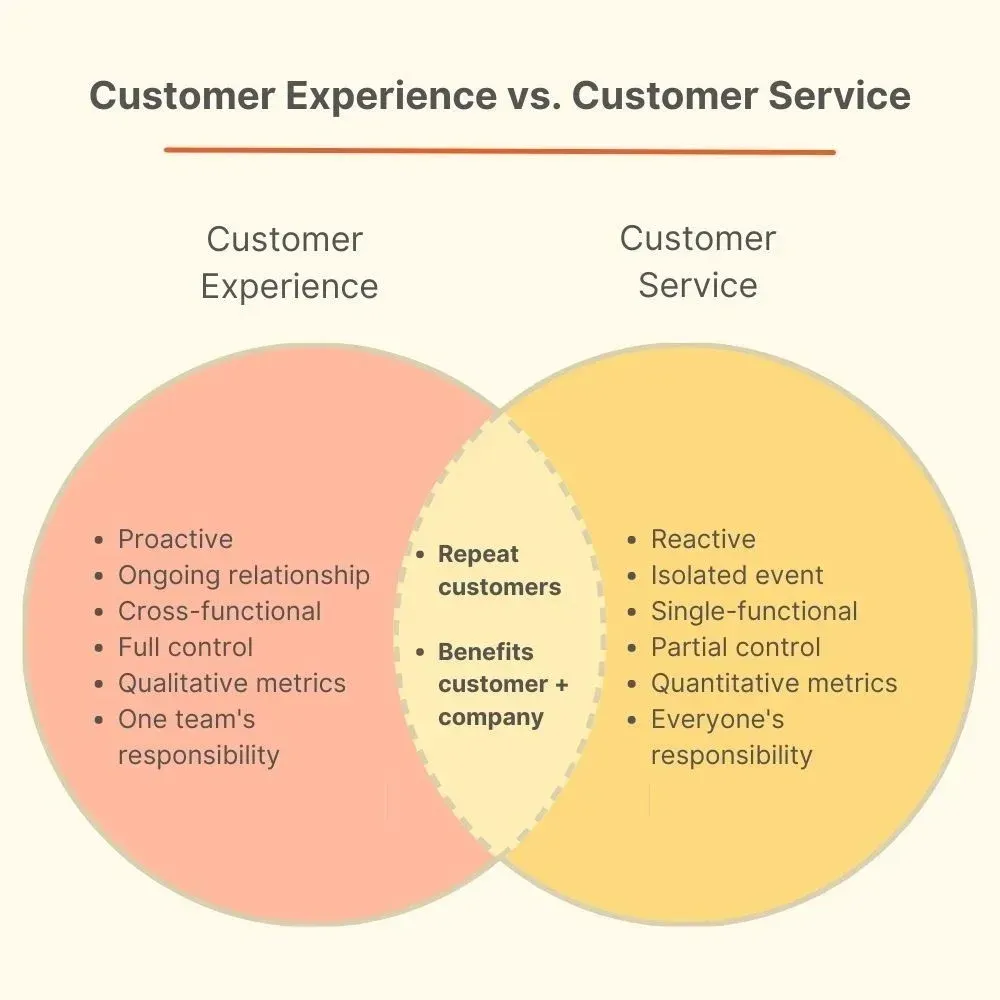On this page
- What is customer service?
- What is customer experience?
- Customer service vs customer experience: What differentiates them?
- Customer service vs. customer experience: Which deserves more attention?
- Examples of customer experience
- Examples of customer service
- How rewards and gifting elevate customer experience and service with Loyalife
This guide embarks clearly upon differentiating between customer experience and customer service, what are the metrics of customer experience and how to measure them - along with some of the best examples of customer experiences all across the globe to upend your learning.
In the entire lexicon of business, there are hardly any other terms than customer service and customer experience that have been used interchangeably - both by the bonafide experts and laymen.
The intermittence stems from their overarching overlapping in each other’s functions. But the fact is, there is a line of difference between the two, however thin it may be.
What is customer service?
Customer service is the act of assisting and advocating for your customers before, during, and after the purchase of a product or service. (Source: Salesforce)
Excellent customer service goes far beyond quick, generic replies. It’s about making a real effort to resolve issues and deliver the most suitable solutions to every customer.
Smart businesses recognize that how they treat customers can determine whether those relationships thrive or fall apart. That’s why they prioritize service that meets rising customer expectations:
- They respond quickly. A majority of customers consider response time one of the most critical aspects of quality service.
- They lead with empathy. Many customers want to engage with support agents who are not only helpful but also compassionate and approachable.
- They meet customers where they are. Today’s customers prefer getting help through familiar channels—like WhatsApp or Facebook Messenger—just as they would when talking to friends or family.
What is customer experience?
Customer experience is the holistic impression that a customer has on a brand in every aspect of a buyer's journey. This impacts the bottom line of a brand, including revenue.
Customer experience is a continuous journey made up of multiple touchpoints. Every interaction—from browsing your website and chatting with a sales or support rep, seeing an ad on Instagram—contributes to how customers perceive your brand.
At its core, customer experience is driven by three key elements: people, process, and product.
- People: Customers value friendly, knowledgeable staff. Whether it’s a conversation with a sales rep or a support interaction via live chat, they expect professionalism and empathy.
- Process: Smooth, hassle-free experiences are a priority. This includes streamlined checkouts, quick responses, and easily accessible support that enhances the overall buying journey.
- Product: The product itself plays a major role. Customers look for intuitive, reliable solutions that address their specific needs.
Customer service vs customer experience: What differentiates them?
In simple words, customer service is only a part of the customer journey, whereas customer experience involves all the interactions between a customer and a brand.
Both customer experience and customer service are vital factors for an organization’s success, yet it is hard to draw lines between them. The difference between how consumers use a product and how they communicate with other consumers supporting it is blurred.
With that being said, let’s dive deep into understanding both of them better.
Aspect | Customer Experience | Customer Service |
Proactive vs. Reactive | Proactive – anticipates customer needs through journey mapping, feedback, and funnel analysis. | Reactive – initiated by the customer after facing an issue, typically via support channels. |
Ongoing Relationship vs. Isolated Event | Ongoing – reflects the entire relationship across all interactions over time. | Isolated – tied to a specific event, like reporting an issue or asking for help. |
Full Control vs. Partial Control | Partial control – influenced by multiple external factors like brand perception and market conditions. | Full control – defined processes, channels, and team roles allow businesses to manage service delivery effectively. |
Qualitative vs. Quantitative Metrics | Qualitative – measured through emotional engagement and broader metrics like CLV, churn rate, and retention. | Quantitative – easily tracked through metrics like CSAT, CES, NPS, resolution time, and response rate. |
One Team vs. Everyone’s Responsibility | Everyone’s responsibility – spans all departments from product and marketing to logistics and delivery. | One team’s responsibility – primarily handled by the customer support team, with limited involvement from others. |

Drive effective employee engagement through recognition, rewards, and surveys, with seamless integration of Slack with Xoxoday Empuls.
Customer service vs. customer experience: Which deserves more attention?
Understanding that customer service and customer experience are distinct is just the beginning—the real question is where to focus your efforts. The answer? Both are essential.
Think of customer service as the wrapping on a gift. A beautifully wrapped package creates excitement—but if the gift inside is broken or underwhelming, the entire experience falls flat. A great product might win customers, but poor support can drive them away. On the flip side, some loyal users may never contact support at all—but they wouldn’t be loyal in the first place if the core experience didn’t meet their needs.
Today’s customer expectations are at an all-time high:
- 82% of customers expect their problems to be resolved immediately
- The second biggest challenge for service reps is keeping up with these rising expectations
- 95% of consumers say customer service directly influences their brand loyalty
Rather than choosing between product quality or customer service, brands must focus on both. Delivering excellent experience and responsive support ensures satisfaction at every touchpoint—and builds loyalty that lasts.
Exceptional customer experiences and high-quality customer service go hand in hand—you can't truly deliver one without the other. Even if you've perfected every other aspect of the customer journey, a lack of timely or effective support can quickly unravel a positive perception. When customers don’t receive the help they need, how and when they need it, they’re likely to look elsewhere.
According to a Deloitte report, 65% of retail executives from outperforming companies expect revenue growth of 5% or more in 2024, highlighting the link between superior customer experience and increased revenue.
A Forbes article highlights that 88% of customers in 2024 consider customer service more important than ever, up from 83% in previous years.
A McKinsey article indicates that companies implementing successful experience-led growth strategies can increase customer satisfaction by at least 20%, leading to significant financial benefits, including increased cross-sell rates and share of wallet.
Forward-thinking businesses understand that this isn’t an “either/or” scenario. Instead, they focus on blending great service with memorable experiences to enhance customer satisfaction and drive long-term success.
Examples of customer experience
Let’s consider a digital example: a customer visits your website to purchase a subscription.
They first discover your brand through a social media ad that caught their attention with a limited-time offer. Clicking through, they find a fast-loading website with an intuitive layout that helps them compare plans easily. The checkout process is smooth, with flexible payment options and clear instructions.
During checkout, they have a quick question and use the live chat support. The representative responds within seconds and resolves the query politely. After purchase, they receive a personalized thank-you email with helpful tips on getting started.
Here again, customer service—the live chat interaction—is just one part of a seamless end-to-end experience. The ad, the website UX, the payment process, the follow-up—all contribute to the full customer experience.
Here are some additional examples of customer experience in action:
Loyalty programs
These loyalty programs reward frequent shoppers with benefits like “Buy 3, Get 1 Free” or discounts on recurring purchases. While implemented at scale, they still give customers a sense of personal attention and appreciation, encouraging repeat business.
Brand perception
How customers view your brand—especially online—has a big impact. Social listening tools help companies track what people are saying about them. A single bad experience shared on social media can quickly damage a brand’s reputation, making it crucial to monitor and respond to feedback in real-time.
Product design
The look, feel, and functionality of your product (and its packaging) directly influence customer impressions. Thoughtful design shows care and enhances the customer’s perception of your brand.
Customer support
This is where customer experience and service truly intersect. Every interaction with a support representative influences the customer’s perception of your business. Effective, empathetic, and timely support can transform a frustrating issue into a positive experience.
Examples of customer service
Every customer service interaction is a single moment that adds up to a lasting impression—positive or negative—of your brand. Let’s look at a few key examples that shape this experience.
Response time
How fast does your support team respond when a customer reaches out? The timing of your response sets the tone for how customers perceive your service.
Prompt replies show that you value their time and concerns. Speedy support isn't just a "nice-to-have", it’s critical to delivering a high-quality customer experience today.
Support channels
These days, customers expect flexibility—they might reach out through email, live chat, social media, or even WhatsApp. Offering multichannel support ensures you’re accessible wherever your customers are most comfortable.
Whether you’re setting up your first loyalty campaign or optimizing existing workflows, Loyalife’s dedicated support is always within reach—via email, live chat, or personalized demos. The result? Quick assistance, smooth onboarding, and expert guidance to help you build loyalty programs that deliver real results.
Self-service options
Empowering customers to find answers themselves can ease the load on your team and improve satisfaction.
Top self-service options include:
- AI-powered chatbots
- Comprehensive knowledge bases
- Step-by-step tutorials
One standout is Canva’s help center. It doesn’t just answer questions—it anticipates them. Using AI, it interprets the user's intent and responds in their native language automatically. That’s a self-service experience that truly works.
Gathering customer feedback
Listening to your customers is essential—but surprisingly, some major brands overlook this crucial aspect. When companies fail to collect feedback or respond to concerns, they create a gap between themselves and their users.
Over time, even the most beloved brands can lose loyalty and trust because customers feel unheard or undervalued. Ignoring feedback doesn’t just hurt customer satisfaction, it damages your brand’s reputation, invites negative word-of-mouth, and opens the door for competitors who are willing to listen and adapt.
How rewards and gifting elevate customer experience and service with Loyalife
Today’s customers expect more than just great products—they seek brands that deliver standout experiences. To stay ahead, companies need to create emotional connections at every touchpoint. That’s where Loyalife shines, helping brands integrate strategic rewards and gifting into the customer journey to enhance experience and service.
Here’s how Loyalife makes it happen:
1. Transforming positive interactions into lasting memories
With Loyalife’s dynamic loyalty engine, brands can turn routine interactions—like feedback submissions or service resolutions—into standout moments. By automating personalized rewards (such as digital gift cards or perks) right after a positive touchpoint, you build stronger emotional bonds that keep your brand top of mind.
2. Driving valuable feedback with meaningful incentives
Collecting feedback is easier when customers feel appreciated. Loyalife’s rule engine lets you configure real-time reward triggers—offering points, vouchers, or perks in exchange for survey participation or reviews. This not only boosts response rates but deepens engagement by showing customers their opinions matter.
3. Repairing relationships with thoughtful gestures
When things go wrong, quick and sincere recovery is key. Loyalife enables brands to respond to service issues with empathy, using customizable gifting options—like digital rewards or curated experiences—to rebuild trust and give customers a reason to return.
4. Deepening loyalty with personalized rewards
Loyalife’s advanced member management tools allow you to track customer milestones—birthdays, anniversaries, purchase anniversaries—and deliver personalized rewards automatically. These tailored touches make customers feel valued, turning occasional buyers into loyal advocates.
5. Creating cohesive omnichannel engagement
Through seamless integrations and omnichannel engagement tools, Loyalife ensures rewards are delivered consistently—whether via email, SMS, in-app notifications, or social media. This unified experience keeps customers engaged across platforms, reinforcing your brand’s presence at every step.
Loyalife helps transform rewards and gifting from transactional gestures into strategic loyalty drivers—elevating both customer experience and long-term satisfaction.
Loyalife equips you with everything you need to transform customer service touchpoints into loyalty-building moments.
Want to enhance your customer experience with smart, personalized rewards?
Book a demo today to see how Loyalife can help you build meaningful engagement and lasting retention.


